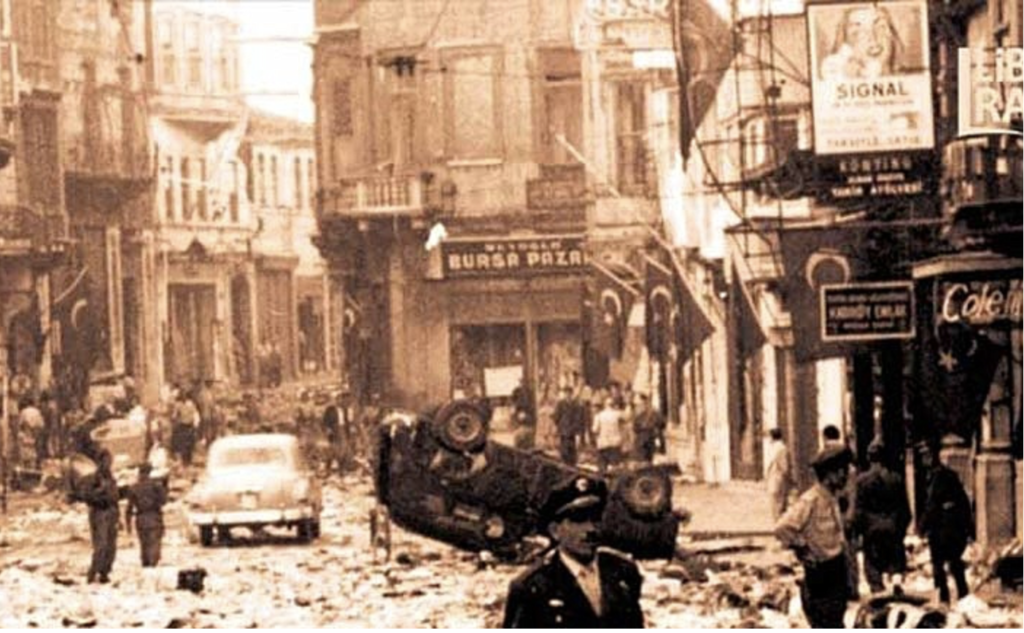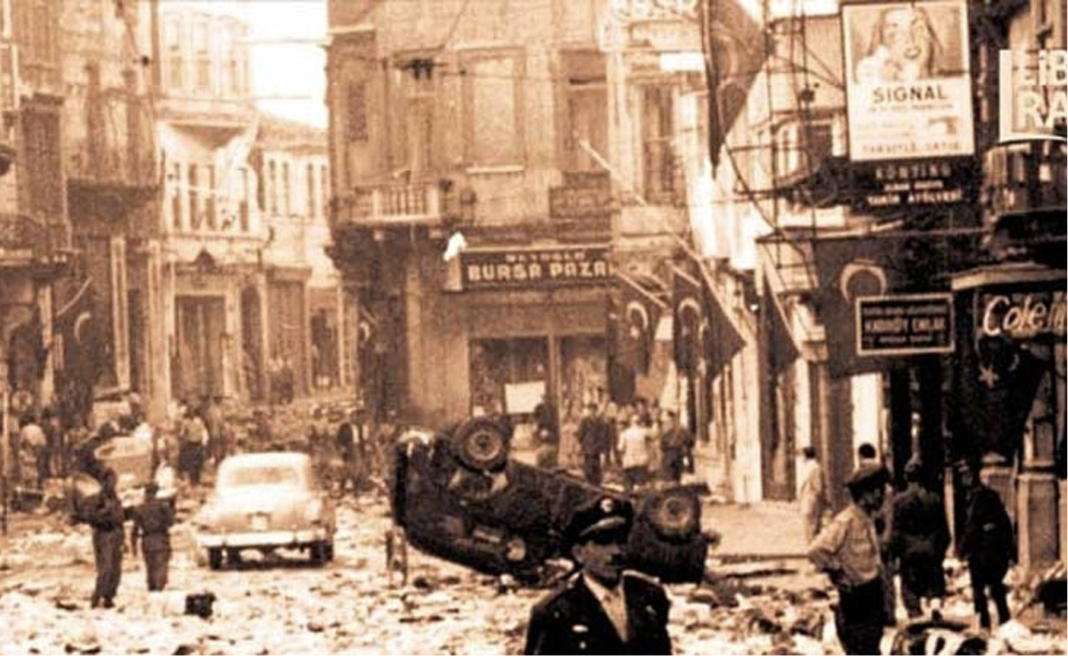« It’s essential not to forget that a significant portion of the remaining Christians and Jews from the Ottoman period were lower-class peasants and workers. Consequently, we need to shift our focus and keep it more extensive, » says historian Emre Can Dağlıoğlu. Published by Bianet English on 6 September 2023.
Today marks the 68th anniversary of one of the most significant attacks against minorities in Turkey, known as the September 6-7 pogrom.
Sixty-eight years ago today, on Tuesday, September 6, 1955, at 13:00, an announcement was made on the state radio, followed by headlines in the Istanbul Ekspres newspaper, which supported the then-ruling Democrat Party (DP) stating « Our leader’s house was damaged by a bomb » (referring to the house of Mustafa Kemal Atatürk during his childhood in Thessaloniki). Shortly after this, attacks against Greek, Armenian, and Jewish citizens began.
Images of destruction and attacks in places like Istanbul’s Beyoğlu and Kurtuluş districts provide crucial evidence of the scale of the attacks. It became evident how widespread the violence was. But what happened in cities outside Istanbul where minorities lived?
Historian Emre Can Dağlıoğlu replied to our questions and provided insight into this.
« A climate of fear created outside Istanbul, too »
First of all, is it correct to focus on the September 6-7 pogrom only looking at Istanbul?
One of the reasons for our Istanbul-centric approach is the intensity of violence in Istanbul. However, this doesn’t mean that nothing happened outside Istanbul. Especially in Izmir, where a significant number of Greeks lived, we see serious incidents of violence.
When I say « not serious, » I’m not comparing it to Istanbul. Nevertheless, we do see incidents of violence against minorities in other places, although not as intense as in Istanbul.
Can you describe it province by province?
For example, in Izmir, 15 houses and nearly 10 businesses were looted and attacked. We can see evidence of looting and attacks. In Alsancak, a church and the Greek Consulate were burned.
At the same time, we see that the Greek pavilion at the fairground was also burned. We see injuries and damage to properties. After the attack on the consulate, it became a diplomatic issue between Greece and Turkey.
Turkey paid compensation for the repair of the consulate building and offered a ceremony with ministerial-level participation as a gesture of goodwill. But there’s another aspect to this. The events of September 6-7 were not isolated. A week later, a church in Izmir was attacked again and set on fire.
So, looking at other cities, what was the extent of violent incidents?
In these cities, we see that while violent incidents were possible and there were marches and gatherings, they were prevented with the intervention of the police and through bureaucratic channels.
For example, in Bursa, on the night of September 6, about 100 Greeks living in the city were placed in a hotel, and that hotel was placed under protection.
Similarly, in Samsun, a small number of remaining Greek families were protected by the police.
Aside from that, there were significant demonstrations in Ankara and Adana. Here, we see that there were demonstrations in neighborhoods where only a small number of minorities remained, and they even clashed with the police, but these incidents did not result in casualties or property damage under military control.
However, after September 6-7, there was an explosion at the Aziz Nikola Church in İskenderun, which suffered severe damage from the February 6 earthquakes this year. It was revealed that two unidentified individuals placed dynamite at the church’s door.
In addition to Istanbul and Izmir, there has been no development regarding the perpetrators of these events. The trials related to these incidents have been very problematic.
There were incidents of violence against Assyrians in Urfa, Mardin, and Midyat, as well as harassment against Jews in Çanakkale.
« Perpetrators went unpunished »
What about the perpetrators?
The process related to the perpetrators is problematic. We see that the Democrat Party detained a large number of people in a short period. However, these detainees were gradually released without proper legal processes, and very few suspects were held. Most of them were released, and they went unpunished.
Later, it was claimed by the Democrat Party that communists had orchestrated this, and the blame was shifted onto leftist writers and intellectuals.
In the trial of Democrat Party members after the May 27, 1960, coup, we see that the 6-7 September Pogrom was portrayed as something organized solely by the leadership of the Democrat Party, which excluded the mass nature of this crime.
But besides the high number of participants in the lynching in Istanbul, we also know that people from Eskişehir, Ankara, Kocaeli, and Sakarya heard about the events and got on buses to go to Istanbul to participate in the crime.
Can we summarize the places where the incidents were concentrated outside Istanbul? Are they İskenderun, Adana, Izmir, and Bursa?
We can also add Mardin, and Urfa to the list. Even though we may not be able to talk about significant acts of violence in these cities, at least we can say that there was mass participation. Ankara, Izmir, and Adana definitely had such incidents.
So when we talk about this, for example, when we walk around in Istanbul, in Beyoğlu, or when we go to Kurtuluş, we say, « The Greeks used to live here. » We tell this story. We almost see traces of them in every building. But what is the situation when we go to other cities?
We can also see this nostalgic reminiscence, traces of Greeks, Jews, or Armenians in cities like Izmir, Ankara, and Çanakkale, where very few of them are left now.
Before the earthquake, Antakya and to some extent, Mardin differ in this sense. They are closer to Istanbul in that regard. Because non-Muslims in those areas are not like museum artifacts; they are part of daily life and exist as themselves in the daily life of these cities. However, even in these cities, we cannot see traces of crimes that seriously damaged the cultural heritage of these communities. They are not memorialized as crimes.
Have there been migrations away from other cities, besides Istanbul?
There was a photo shared on Twitter by Bora Selim Gül. It’s a plaque in front of one of the famous historical courtyard houses of Antakya. It’s about a house built by a Syrian family, and there’s a sentence on the plaque stating that the heirs of this house left Antakya after the events of the September 6-7 pogrom in 1955. So we don’t know why or for what reasons people left, but we can say that the September 6-7 pogrom played a significant role in creating a climate of fear and contributed to the migration of some people, especially in Anatolia.
I’d like to highlight another detail as well: We talked about the church in İskenderun. Ultimately, we can explain that what happened on the night of September 6 and was heard in Hatay and the surrounding areas on September 7 created a climate of fear. In Altınözü, where two Christian villages are located, we know that people gathered in large houses and used whatever makeshift weapons they could find to protect themselves and lived together for a few days. Therefore, even if it did not lead to intense destruction, it created a certain fear, which could affect emotions, and socio-economic positions, and even change them.
When it comes to the issue of minorities, in the context of Turkey’s history, one of the main problems is the dominance of Istanbul-centered perspectives.
Studying the minority issues, it is clear that this is the result of a class-based perspective. It is easier to see the more prosperous, those who left beautiful and tangible things behind. Of course, remembering their beautiful houses, churches, large properties, and wealth is easy. However, it’s essential not to forget that a significant portion of the remaining Christians and Jews from the Ottoman period were lower-class peasants and workers. Consequently, we need to shift our focus and keep it more extensive, in my opinion.
Published by Bianet English on 6 September 2023.


